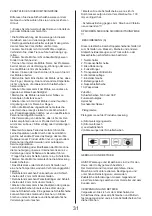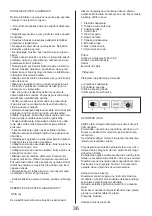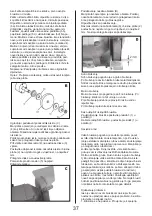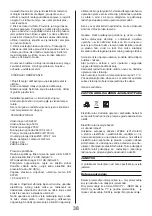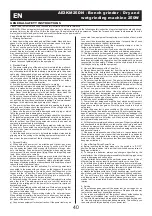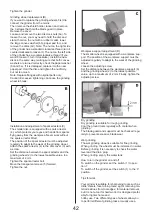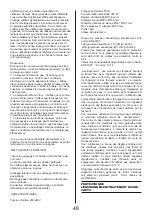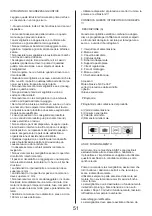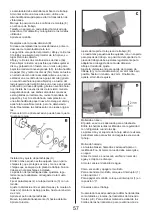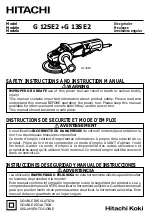
rough grinding wheel for rough grinding, i.e. to re
-
move larger amounts of material. To achieve a finer
surface, use a medium-rough grinding wheel. If the
grinder is used to grind soft metals such as aluminum,
the wheel will clog quickly and need to be replaced.
Always let the grinder do its job, do not overload it,
do not apply excessive pressure to the blade / cutting
tool. Try to use a knife support to support and guide
the edge. Do not grind by using the side surfaces of
the grinding wheel, as excessive pressure on the side
of the wheel could damage it.
Troubleshooting
Although your new bench grinder is very easy to op
-
erate, if problems occur, check the grinder as follows:
1. The grinder does not start: Check that it is con
-
nected to the mains; verify with an electrical tester or
other electrical device; check the connections in the
socket; check and tighten loose connections; check
fuse; in case of suspicion, replace the new one with
the correct performance.
2. The disc shakes or vibrates: Check that the lock
nut is tightened. Check that the disc is mounted
correctly on the shaft and on the washer. If excessive
pressure is applied or the blade is „stuck“, it may be
damaged and cause vibration. As soon as there is
any sign of damage to the blade, do not use it, but
disassemble it and replace it with a new blade.
3. The blade leaves a rough surface. Excessive pres
-
sure on the disc can cause incorrect surface finish.
If you work with aluminum or similar soft alloys, the
blade will clog very easily and will not grind effectively.
There are no user serviceable parts inside this
grinder. In case of problems, take the grinder to an
authorized service center.
CLEANING AND MAINTENANCE
! Before cleaning and maintenance, always unplug
the tool.
The tool does not require any special maintenance.
Never clean any part of the tool with a hard, sharp or
rough object.
Storage when not used for a long time
Do not store the tool in a place where the temperature
is high.
If possible, store the device in a place with a constant
temperature and humidity.
SPECIFICATIONS
Input voltage 230-240V
Input frequency 50 Hz
Power consumption 250 W
Idle speed 2840/134 min-1
Grinding wheel diameter Ø200 / Ø150 mm
Inner diameter of the disc Ø20 / Ø12.7 mm
Max. thickness no. discs 40/20 mm
Weight 10 kg
Protection class I.
Sound pressure level measured according to EN
60745:
LpA (sound pressure) 72,1dB (A) KpA=3
LWA (sound power) 83,1 dB (A) KwA=3
Take appropriate measures to protect your hearing!
Wear hearing protection whenever the sound pressure
exceeds the level of 80 dB (A).
Weighted effective acceleration according to EN
60745:
<2,5 m/s2 K=1.5
Caution: The vibration level may vary during power
tool operation from the declared value depending on
the way the power tool is used and depending on the
following conditions: Method of power tool use and
type of material being cut or drilled, conditions of the
power tool and method of its maintenance, appro
-
priateness of the used accessories and ensuring its
sharpness and good conditions, the strength of handle
gripping, use of anti-vibration equipment, suitability of
the power tool for the purpose for which it has been
designed and compliance with workflows according to
manufacturer‘s instructions.
If this power tool is used in an inappropriate manner, a
hand/shoulder vibration syndrome may appear.
Caution: For clarification, it is necessary to consider
the level of vibrations in specific conditions of use in all
operating modes, e.g. the time when the power tool is
switched off except for the operation time, and when
it idles, i.e. performs no work. This may substantially
decrease the exposition level during the whole operat
-
ing cycle.
Minimize the risk of vibrations, use sharp chisels, drill
and blades.
Keepthe power toolin compliancewith theseinstruc
-
tions and provide for its proper lubrication.
When using the power tool regularly, invest into anti-
vibration equipment.
Do not use the power tool under temperatures lower
than 10°C. Plan your project containing work with the
power tool producing high vibrations carefully and
spread it over more days.
Subject to changes.
ENVIrONmENTAL PrOTECTIONWASTE mA
-
NAgEmENT
Power tools, accessories and packaging should be
provided for recycling and not to harm the environment.
Do not dispose of power tools into household waste!
According to Directive 2012/19/EU of the European
Parliament and of the Council on waste electrical and
electronic equipment (WEEE) and its approximation
in national laws, unfit power tools must be handed
over at the point of purchase of similar equipment, or
in available collection points designated for collection
43



